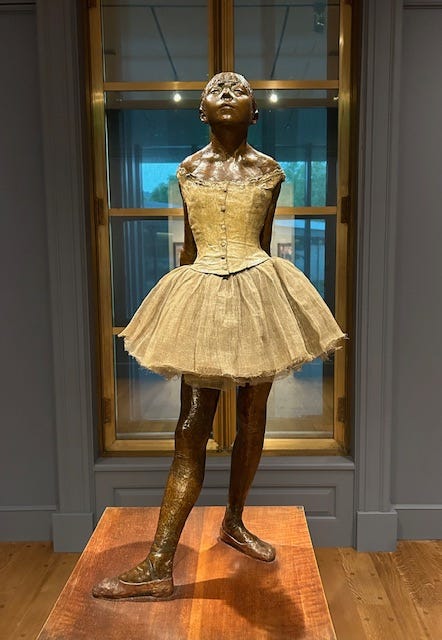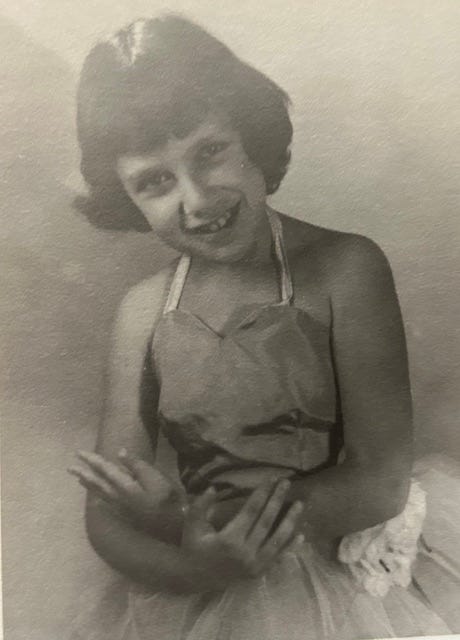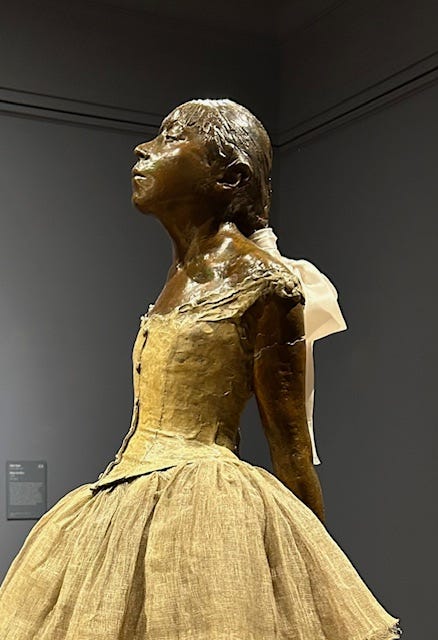On the Trail of Degas' Little Dancer
She once embodied my ballerina dreams. Decades later, I love her even more for the harsh truth about her life.

Our relationship began with my mother. She made the introduction at my first art museum, the grand temple in Boston. We rode the dawn bus from New Hampshire, then boarded a subway car that smelled of dust and sweat. I followed my mother through galleries lined with wizened baby Jesuses and grizzled old folks in black. Who knew ceilings could be so high? At last she appeared, the role model of my ballet years—Degas’ “Little Dancer.” We had her to ourselves, as if she’d been waiting for this moment. My mother drew me close. “Look, Rona. She’s wearing a real tutu and a real hair ribbon.”
She stood in a rakish fourth position, head upturned and eyes half-closed in what looked to me like rapture. Could there be a more beautiful creature? Let’s say I was seven (there’s no one left to deny it). Knock-kneed and pot-bellied, but in my dreams a twirling sylph. I longed to stand on the Little Dancer’s pedestal, strike her pose. I longed for the flowers, the applause, the whole glittering life of a 14-year-old ballerina, young enough to be my big sister. She alone affirmed what I believed with all my heart: Ballet was my calling.
Once art goes into the world, it no longer belongs to the artist. People make of art what they will. Generations of ballet-mad girls have looked up to the Little Dancer, and their fervor would astonish Degas. When he unveiled her at the Sixth Impressionist Exhibition of 1881, Parisians recoiled in disgust. They compared her to a monkey, an aborted fetus, a specimen for a museum of medical monstrosities. Made of wax and dressed in a wig of human hair as well as human clothes, she resembled no sculpture ever seen. Where was the gleam of bronze, the face worthy of a goddess? This urchin had a sloping forehead and forward-thrusting jaw, then considered signs of degeneracy.
Back to the studio went the Little Dancer. There she remained until after Degas’ death, when his heirs had her cast in bronze at least 27 times. The Little Dancer made her entrance at museums far and wide. She would inspire a movie, a musical, all manner of chachkas and a bevy of books about Degas’ teenage model, a real-life dancer named Marie van Goethem. A children’s book about Marie so enchanted one little girl that her mother launched a Little Dancer pilgrimage to every statue in a public collection.
I will soon turn 75. My arthritic toes haven’t pointed since John Travolta lit the disco inferno. I only go to the ballet if someone twists my arm, but I’m a die-hard on the art museum trail, where the Little Dancer turns up all over the place. Paris, London, Dresden, Copenhagen. Across the U.S., from New York to Pasadena. Without even trying, I must have seen half the incarnations of the sculpted teen in the real tutu (yellowed, more often than not). And yet I didn’t see her, not really. She competed for attention with brighter things—water lilies, sunflowers, blithe Parisians on Sunday outings. “You again,” I would think, breezing past.
Then last week, during an art road trip with my husband, the Little Dancer caught my eye at the Clark Art Institute in Williamstown, Massachusetts. She reigned over a small gallery of her own, an oceanic shade of blue (or was it gray?) that brought a glow to her bronze complexion. I looked at the face that had scandalized Paris—hardly monstrous, but a far cry from beautiful. Degas could have given her classically proportioned features. Instead he gave her an inner life. Where I used to see rapture, or perhaps the meditative state of preparation for the next pirouette, I now saw resolve and more than a hint of defiance. If I had raised a daughter, I might know that look. It would tell me I was in for a fight. I’d want to out-argue and protect her in the same moment. Yeats flared in my head:
And thereupon my heart is driven wild:
She stands before me as a living child.
Who was Marie von Goethem? What little we know is grim. Her parents, a laundress and a tailor, bounced from one hovel to the next, unable to pay the rent. The tailor died young, tightening the noose of need. All three van Goethem daughters were sent to the Paris Opera Ballet school, where hungry girls as young as 10 joined the flock of petits rats (little rats) vying for jobs in the corps de ballet and the protection of well-heeled men who looked them over in the foyer de danse. It’s not much of a stretch to say Madame van Goethem pimped her daughters. And she’d retort, if she could, “What else was I to do?” The oldest von Goethem sister drifted into sex work and ended up in jail. Marie had reached the corps by the time Degas found her. She couldn’t say no to a side hustle as his model.
As far as anyone can determine, Degas never used her sexually, but he did pose her naked for a series of preliminary studies. I ache for the stripped Marie. Her breasts hardly exist; her ballerina legs seem even longer without her tutu. On these legs—toned and tightened at the barre, rapped by the ballet master—she bore the weight of her impoverished family. For daughters of privilege, ballet is a portal to enchantment. For Marie it was child labor. Not long after she posed for Degas, she was fired for missing rehearsals and vanished as poor young women do who have nothing to sell but their bodies.
Ballet is the art of illusion—earthbound bodies that conjure flight, feet that seem to twinkle on pointe shoes (the audience doesn’t see the bunions). Degas painted more ballerinas than anything else, enthralled by the sweat and strain behind the scenes. His dancers yawn, scratch their backs and straighten twisted stockings. They slump with splayed legs, no more graceful than a laundress at the end of her shift. Degas, who painted laundresses too, understood what Marie had in common with her mother. Yet unlike all Degas’ other working women, whose faces are blurs, Marie has a many-layered expression. I wonder what she’s thinking and know she doesn’t care. Alone on her pedestal, she looks past me into a world known only to herself. She is pride standing up to pain, a ragamuffin hoping against hope for a better life than her mother’s.
Looking at art is a conversation. This one began in Boston more than 65 years ago. Marie is done talking. It’s my turn now. Three words will do: “I see you.”
Online resources:
A BBC series, “Private Life of a Masterpiece,” includes a fascinating episode on the Little Dancer.
Camille Laurens, author of Little Dancer Aged Fourteen: the True Story Behind Degas’ Masterpiece, offers a preview here. And here’s a review from The New Yorker. I haven’t read the book.
The National Gallery of Art in Washington, D.C. owns the original wax sculpture and provides an enlightening overview of its history.
For background on Degas and dancers, I recommend this article from Smithsonian Magazine. And art historian John Richardson wrote this for Vanity Fair.
Your turn, my friends. What do you see in the Little Dancer? Do you have a personal history with ballet? Don’t feel constrained by my questions—take this discussion where you’re moved to go. I do my best to answer every comment. And speaking of comments, I’m particularly touched by this one, from new subscriber Brenda Dyck: “As captivating as your essay was…, what struck me was that you responded to each and every person who posted a response…. You made each of these people feel like their response mattered to you and deserved recognition.” Thank you, Brenda!
We writers need readers to keep us motivated. I’m grateful to everyone who joins me here. You don’t need a paid subscription to read all my posts and be one of my favorite people in the world. I’m here for the joy of connection, not for money. So feel free to share this post. If you’re in the mood to purchase a subscription, you’ll be sending me a rainbow.








I did not know that Parisians did not fall in love with his Little Dancer and only after his death was it cast in bronze. I did not know the back story of the model. And I didn't know of your aspirations for ballet as a young girl, but I did learn to SEE this work of art in a whole new way. Thank you!
I never had ballerina aspirations, but I remember walking into a room at the Smithsonian as an adult, and there she was. I literally gasped. I had never expected to see her. I’d always been moved by her. I didn’t know there were many castings of her and didn’t know the sad story of Marie. Thank you.